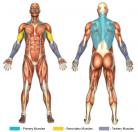Rear Pull-Ups (Calisthenics)
- Face the raised pull-up/chin-up bar, and, if necessary (due to bar height), either using a small stool or jumping, grasp the bar with an overhand grip (i.e. thumbs facing one another) at the desired width (generally a medium grip is preferred for this exercise) and hang.
- Pull the base of your neck to the bar, keeping your body upright, while exhaling throughout the movement. Your elbows may point toward the sides or forward.
- Slowly lower your body to the starting position, letting the arms fully extend (without letting the elbow joint slam as the arms are straightened), while inhaling throughout the negative motion.
- Repeat steps 2-3 for as many repetitions as are desired.
The primary muscles worked by rear pull-ups are basically the same as traditional pull-ups; the real difference is the slight shift in focus to the upper back muscles. Just as traditional pull-ups, the latissimus dorsi and the teres major are targeted. Additionally, when the shoulder blades are squeezed together at the end of the movement, both the trapezius (upper through lower) and the rhomboids are recruited. This squeeze is necessary for the entire bulk of the back to be worked.
How to make pull-ups easier:
Pull-ups are prime among back exercises, however, they are not a particularly easy exercise, and as such many people may not be able to perform them. This is okay because most gyms have a machine that provides aid for this very problem. The machine is an assisted pull-up/dip machine. It works by removing part of one's body weight so as to make the pull-ups doable. Specifically, a pad, which is connected by a cable to weighted plates (which can be set to the lifter's choosing), goes beneath the knees and removes a percentage of weight from each pull-up, thereby making the lift possible.
How to make pull-ups more difficult:
For those that desire a greater challenge (i.e. a more intense lift), a weighted dip belt may be used to add weight to the lifter's weight. In this manner, the exercise maybe be made to be as difficult as one desires; one could add 5 pounds or 150 pounds to their body weight, for example. See "Dip Belt" for a picture of this equipment.
This exercise may present performance difficulties for certain people. Inflexible shoulder or neck muscles/joints may preclude the possibility of performing the motion (at least comfortably). If this is the case, do not fret because you may simply perform traditional pull-ups.





